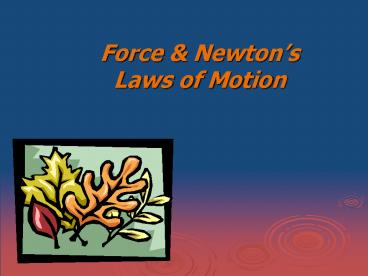Force - PowerPoint PPT Presentation
1 / 33
Title:
Force
Description:
Force & Newton s Laws of Motion – PowerPoint PPT presentation
Number of Views:191
Avg rating:3.0/5.0
Title: Force
1
- Force Newtons Laws of Motion
2
FORCE
- Act of pulling or pushing
- Vector quantity that causes an acceleration when
unbalanced - Forces can cause objects to
- Start moving
- Stop moving
- And/or change direction
3
NEWTON
- SI Unit for Mass kilogram (kg)
- SI Unit for Acceleration meters/second2
- SI Unit for Force Newton (N)
- Newton Amount of force that, when acting on
a 1 kg mass, produces an acceleration of 1 m/s2 - 1 N 1 kg x 1 m/s2
4
NEWTONS FIRST LAW
- Objects move at constant velocity unless acted
upon by a net force - Every object continues in a state of rest, or
of motion in a straight line at constant speed,
unless it is compelled to change that state by
forces exerted upon it
5
MASS
- Measures an objects resistance to change
velocity - Quantity of matter in an object
- Mass is NOT weight
6
Gravitational ForceWEIGHT
- Force of gravity on an object
- Downward pointing vector
- W mg
- Weight mass x acceleration due to
- gravity
7
QUESTION
- What is Franks weight on Earth?
- (HINT His mass 80.0 kg)
- Answer
- W mg
- W (80 kg)(9.8 m/s2)
- W 784 N
8
NET FORCE
- In the absence of force
- - Objects at rest, remain at rest
- - Objects in motion, continue in motion
- NET FORCE
- - Combination of all forces acting on an object
- - Net force ? Changes an objects state of motion
9
NET FORCE Remember ? Force Vector,
represented by an arrow
- Applied Forces Net Forces
5 N
15 N
10 N
10 N
5 N
5 N
5 N
5 N
0 N
10
EQUILIBRIUM
- An object is in equilibrium when it has zero
acceleration - Net force on the object equals zero
5 N
5 N
11
NEWTONS SECOND LAW
- Acceleration of an object
- Directly proportional to the net force acting on
the object - Inversely proportional to the objects mass
- Net force mass x acceleration
- (Newtons) (kg) x (m/s2)
- Rearranged
12
Question
- What is the boxs acceleration?
- Mass of the box 15 kg
- F 158 N
- a ?
13
Question
- What is the boxs acceleration?
- Answer
- SF ma
- F (-mg) ma
- a (F - mg)/m
- a (158 N -147 N)/(15 kg)
- a 0.73 m/s2 (upward)
14
NEWTONS THIRD LAW
- Forces come in action-reaction pairs
- Equal in strength, opposite in direction
- Forces act on different objects
- Fab -Fba
- Force of a on b opposite of force of b on a
15
Question
- The weight of the apple is 1.5 N. When the apple
hits the ground, what force does it exert on the
Earth? - Answer 1.5 N upward
16
Equilibrium When the Net Force Equals Zero
- What forces act on a motionless block sitting on
a table?
17
NORMAL FORCE (FN)
- Occurs when 2 objects are in direct contact
- Acts at right angles to the surface
- Perpendicular to the surface
18
TENSION (FT)
- Force conveyed through a string, chain, rope,
tendon, etc.
19
A massless rope will transmit tension
undiminished from one end to the other. If the
rope passes around a massless, frictionless
pulley, the tension will be transmitted to the
other end of the rope undiminished.
20
Free-body Diagrams
- Shows all external forces acting on a body
- Force vectors
- Point in the direction of the force
- Often drawn from the origin
21
Net force on the car 275 N 395 N 560 N
110 N Directed along the x axis of the
coordinate system.
22
If the mass of the car is 1850 kg then, by
Newtons second law, the acceleration is
23
FRICTION
- Resistive force
- Acts in a direction opposite to the direction of
the relative motion of 2 contacting surfaces - Varies by materials in contact
- Proportional to the normal force between the
objects - Draw vector parallel to the surface
24
Note that the magnitude of the frictional force
does not depend on the contact area of the
surfaces.
25
The Force of FRICTION
- Static Friction
- Force that resists the initiation of sliding
motion between 2 surfaces that are in contact and
at rest - fs, max msFN
- fs, max Maximum static friction force
- ms Coefficient of static friction
- FN Normal force
26
When the two surfaces are not sliding across one
another the friction is called static friction.
27
(No Transcript)
28
The Force of FRICTION
- Kinetic Friction
- The force that opposes the movement of 2 surfaces
that are in contact and are sliding over each
other - fk mkFN
- fk Force of Kinetic Friction
- mk Coefficient of Kinetic Friction
- FN Normal Force
29
(No Transcript)
30
The sled comes to a halt because the kinetic
frictional force opposes its motion and causes
the sled to slow down. Suppose the coefficient
of kinetic friction is 0.05 and the total mass
is 40kg. What is the kinetic frictional force?
31
Suppose the coefficient of kinetic friction is
0.05 and the total mass is 40kg. What is the
kinetic frictional force?
N mg (40kg)(9.8m/s2) 392 N fk
(0.05)(392N) 19.6N
32
The direction of force and acceleration
vectors can be taken into account by using x and
y components.
is equivalent to
33
4.11 Equilibrium Application of Newtons Laws of
Motion
Definition of Equilibrium An object is in
equilibrium when it has zero acceleration.































